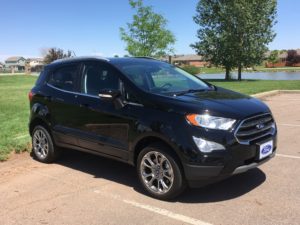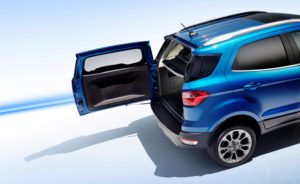
Ford SUVs sold in record numbers in June, emphasizing its recent decision to soon get out of the business of building automobile sedans.
I’ve driven its newest, and smallest, SUV – the subcompact Ford EcoSport. Rounding out Ford’s strong SUV/crossover lineup are the Escape, Edge, Explorer, Flex and Expedition.
Ford sold more than 77,000 of these models in June, an increase of 8 percent over the same month a year ago, and for the first half of the year have surpassed 400,000 in sales. Even higher sales of the F-series pickups brightens the coming production schedules.
Fiat Chrysler Automobiles and General Motors find themselves in the same sales game, moving all the SUVs and trucks they can build, while sales of their midsize and compact sedans are falling sharply.
The EcoSport, a subcompact, is smaller than I’d expected. Its overall length of 161.3 inches is 7 inches shorter than the Buick Encore or the Mazda CX-3. It is considered a five-passenger vehicle, but three adults in the rear seat will be somewhat of a squeeze. The front buckets, particularly the seatbacks, are well-bolstered and very comfortable, and the driver is provided good vision all-around.
Beneath the hood of the EcoSport Titanium with four-wheel drive is a 166-horsepower, 2.0-liter 4-cylinder engine and 6-speed automatic transmission. Base engine for the cheaper front-wheel-drive models is a 1.0-liter, turbocharged 3-cylinder engine of 123 horsepower. Neither engine is quick, though the 4-cylinder’s performance improves in Sport mode.
The first drive Jan and I took in the new EcoSport was south along U.S. 85 through Brighton, then west along 104th Avenue to Grant Street, where we met friends Ted and Shirley King for evening dinner at Cheddars.

An hour or so later, as we walked out to the car, I swung a foot beneath the rear bumper to see if that would open the rear liftgate. It did not and after looking it over for a release, Ted stepped to the passenger side taillight, pushed a button inside an open slot and the rear end opened and swung to one side as a swing gate.
Cargo space behind the rear seat is 20.9 cubic feet, which expands to 50 feet with the rear seat folded.
In an even split of city/highway driving miles, I’ve averaged 25.2 miles per gallon with the EcoSport 4-cylinder. Its EPA estimate is 23/29 mpg. The FWD model with the 3-cylinder power carries an EPA rating of 27/29.
Wheelbases for Ford’s six SUVs/crossovers are 99.2 inches for the EcoSport, 105.9 for the Escape, 112.2 for the Edge, 112.8 for the Explorer, 117.9 for the Flex and 122.5 for the Expedition. An extended-length Expedition stretches out to 131.5 in wheelbase.
Besides the previously mentioned Encore and CX-3, the EcoSport competes against the Toyota C-HR, Hyundai Kona, Subaru Crosstrek, Jeep Renegade and Chevy Trax, along with several others.
BANTER FROM BUD
U.S. Volvo plant: Remember, I told you four months ago it just wasn’t so. So much of the press at that time jumped on the announcement by Volvo that every new launch it makes beginning next year will be equipped with some form of electric power. Some reporters said Volvo was getting out of the internal-combustion-engine business. Not so, I said at the time. Volvo last week announced that it has opened its first U.S. assembly plant at Ridgeville, S.C., to produce S60 sedans and, in a couple years, to add the popular XC90 SUV output to the factory. Both vehicles are powered by internal-combustion engines.